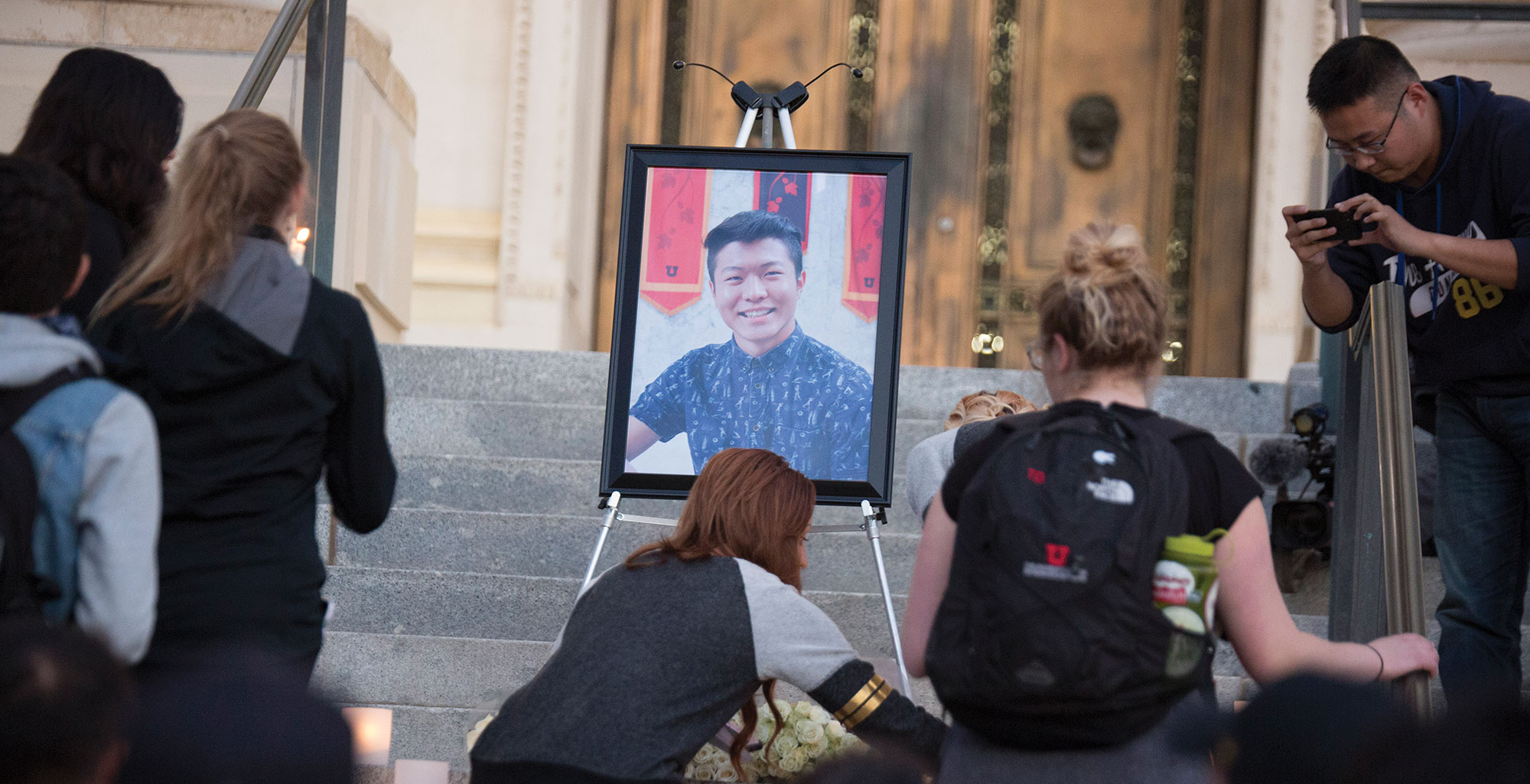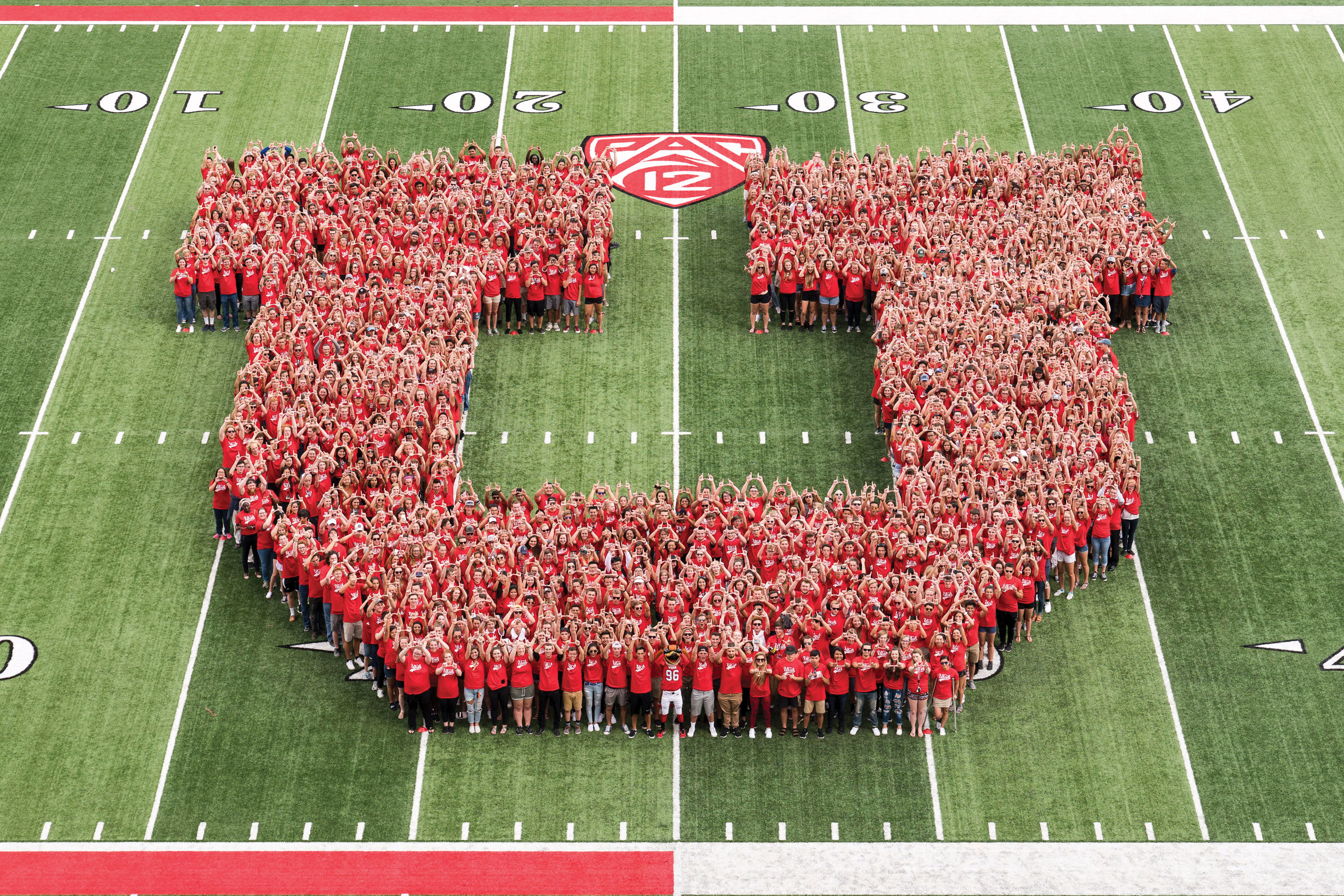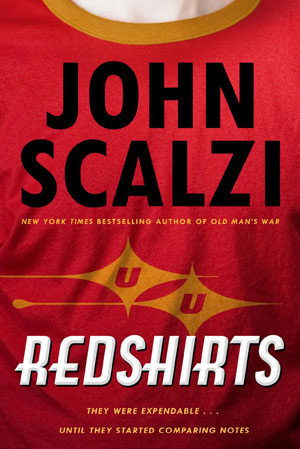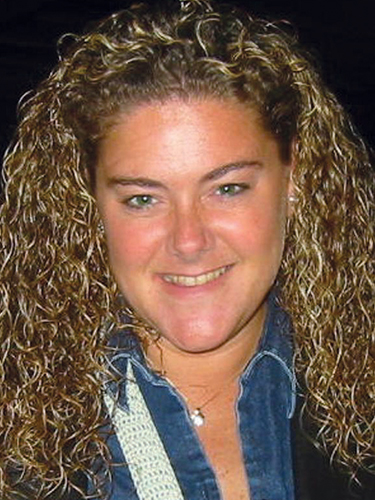
MOURNING ONE OF OUR OWN: CHENWEI GUO
In a show of solidarity and sorrow, hundreds of students, staff, and faculty gathered for a candlelight vigil on the steps of the Park Building on Nov. 1 to honor U student ChenWei Guo, two days after his tragic death.
Speakers at the vigil, sponsored by the Asian American Student Association, recalled Guo’s remarkable and positive character, echoing comments made by all who knew him. “Words cannot describe the pain, confusion, sorrow, and grief that come as a result of this,” said Elena Jin, a close friend of Guo and his family. “ChenWei was most characterized by his selfless service, faith-filled lifestyle, and undefeatable positive attitude.”
Guo, 23, was fatally shot by a 24-year-old man police described as a “drifter” in a failed carjacking near the gate of Red Butte Canyon on Monday evening Oct. 30. A second U student who was with Guo managed to escape. Law officers from across the Salt Lake Valley responded to the U campus to search for the suspect, later identified as Austin J. Boutain. He was arrested the next day after being spotted by a librarian at the downtown Salt Lake City Public Library and faces multiple criminal charges.
“This senseless act of violence has shaken our community and ended the life of a dear son, true friend, and promising scholar,” U President David W. Pershing said. “By all accounts, ChenWei was a wonderful young man, and we mourn his death.” Pershing canceled classes on Tuesday out of respect for Guo. The president also directed that flags at the university be flown at half-staff for the remainder of the week.
Guo was born in Beijing, China, and came to the U.S. in 2012. He graduated from Timpview High School in Provo, Utah, and then served a mission for The Church of Jesus Christ of Latter-day Saints in Provo. Guo transferred to the U from LDS Business College this fall. He was studying computer science and entrepreneurship and worked as a peer advisor in the U’s International Student and Scholar Services Office.
In a bio written for his job, Guo described himself as an adventurous person who liked activities such as skydiving, skiing, horseback riding, dancing, modern fashion, and “French bulldogs!” He hoped to open a consulting business to “help more people feel good about themselves.”
RESEARCHER ELECTED TO NATIONAL ACADEMY OF MEDICINE
 Wendy Chapman, chair of biomedical informatics at U of U Health—whose informatics tools have been applied toward addressing a wide array of problems in health care— has been elected to the National Academy of Medicine (NAM). The high honor comes on the heels of receiving a top accolade in her field, the Donald A.B. Lindberg Award for Innovation in Informatics.
Wendy Chapman, chair of biomedical informatics at U of U Health—whose informatics tools have been applied toward addressing a wide array of problems in health care— has been elected to the National Academy of Medicine (NAM). The high honor comes on the heels of receiving a top accolade in her field, the Donald A.B. Lindberg Award for Innovation in Informatics.
Chapman is most noted for developing informatics algorithms that are now considered a “gold standard” and have been translated into several languages to analyze clinical texts across the world. Her algorithms and tools for natural language processing use computational power to pull data from doctor’s notes and health records that are otherwise hidden from automated analyses.
For instance, finding the word “pneumonia” in a record does not necessarily mean the patient was diagnosed with the illness. Chapman’s algorithms put terms into context by determining if the patient had no pneumonia, a history of pneumonia, or perhaps was at risk. Such information can be applied to decision support tools, identifying cohorts for research studies, and optimizing processes such as billing.
Chapman was among 70 new U.S. members and 10 international members elected to the academy. She is the sixth U faculty member to be elected to the NAM, joining inductees Vivian Lee, Mario Capecchi, Sun Wan Kim PhD’69, Baldomero Olivera, and Carrie Byington.
U REACHES RESOLUTION ON HUNTSMAN CANCER INSTITUTE
In October, the U’s Board of Trustees approved a new agreement between the university and the Huntsman Cancer Foundation that resolves issues raised earlier in 2017. The agreement, signed by U President David Pershing and foundation CEO Peter Huntsman, supplements and clarifies previous understandings regarding the Huntsman Cancer Institute. The two leaders issued a joint statement reiterating the shared goal of the university and the foundation to eradicate cancer and provide compassionate care of those who suffer from the disease.
“We are gratified to have emerged from several months of discussion better positioned to bring together our shared resources,” the statement says. “The agreement… ensures that we will continue to put the patient at the center of a variety of therapies that go beyond cancer treatment, while safeguarding the role of basic research into finding cancer cures, and preserving the resources the institute needs to fulfill its mission.”

MOST GRADS AND FRESHMEN EVER IN 2017
On the heels of saying goodbye in May to its largest graduating class ever (more than 8,500 students), the U broke yet another record this fall with the most incoming freshmen in its history, totaling 4,119—an overall headcount increase of 14 percent from the previous year. The average ACT score is also the highest on record at 25.3, and the number of domestic freshmen who are students of color increased by 15 percent. What an exciting time to join the University of Utah—welcome!
U REITERATES ITS STANCE ON FREE SPEECH AND DACA
Colleges and universities across the nation faced a number of challenges this fall, including controversial speakers whose appearances sparked rallies and protests—testing the parameters of free speech laws—and concerns about President Trump’s decision to phase out the executive order on the Deferred Action for Childhood Arrivals (DACA) program.
The U made national headlines in September alongside UC Berkeley (prompting both cheers and jeers) following an invitation for conservative commentator Ben Shapiro to speak on campus. The invite came not from the university itself, but rather from a registered U student group, Young Americans for Freedom. Shapiro described his speech as taking on “leftist myths of white privilege, trigger warnings, microaggressions, and diversity.” U students and the community gathered on campus that evening to make their voices heard both for and against Shapiro’s message. There were a few incidents that required police intervention, including two arrests, but the majority in attendance exercised their rights to share their views in a peaceful fashion.
Accommodating such speech is a role universities are specifically designed to fill, even when that speech is at odds with values the campus embraces. “Universities are classic free speech zones,” says Michele Ballantyne JD’91, associate general counsel for the U. “A campus is supposed to be a place where people can question, they can formulate and express their thoughts. We believe that as students examine and discuss those thoughts with others of differing views, any flaws in those thoughts will be illuminated.”
Also in September, the U responded to Trump’s DACA announcement with a letter from U President David Pershing, in which he expressed his disappointment in the decision to end the executive order, which was introduced in 2012 to protect immigrants who came to the United States as children and allows them to enroll in college, work legally, and obtain a driver’s license.
“Now, the future of DACA is up to our legislative leaders, and we, at the U, encourage them to recognize the talent and dedication of our students and the value they contribute to society by supporting legislation for them,” wrote Pershing. “The University of Utah is unwavering in its commitment to undocumented students (with or without DACA)…. We stand behind investing in these young people, who are such a vital part of the University of Utah community.”
NEW GRANT TO HELP TREAT CHRONIC BACK PAIN USING
NON-ADDICTIVE METHODS
 The U’s College of Health was awarded a six-year, $6.5 million grant to study non-drug treatment of back pain among active duty members of the military as part of a larger federal partnership with National Institutes of Health, Department of Defense, Department of Veterans Affairs, and 12 universities across the country.
The U’s College of Health was awarded a six-year, $6.5 million grant to study non-drug treatment of back pain among active duty members of the military as part of a larger federal partnership with National Institutes of Health, Department of Defense, Department of Veterans Affairs, and 12 universities across the country.
“Back pain is the No. 1 non-cancer pain complaint for which people get prescriptions that can lead to misuse of opioids,” says Julie Fritz, associate dean of research and principal investigator on the project. “Back pain can be the gateway to addiction.”
Research to find viable alternatives to addictive pain medication is especially pressing in Utah, which ranked seventh in the U.S. for drug poisoning deaths from 2013 through 2015, according to the Utah Department of Health. Most Utahns who die from a drug-related death suffer from chronic pain and take prescribed medications.
Fritz, a faculty member in the Physical Therapy and Athletics departments, and her team of scientists at the U and military hospitals in Texas will study treatment options using a “stepped approach,” starting with broad and less costly treatments that could benefit a wide range of patients. “We are trying to take a really holistic approach. We will start with patient education, sleep management, exercise, and stress reduction,” Fritz says. “For those who don’t respond right away we could move into mindfulness, acupuncture, and other non-pharmacological treatments.”
NIH Director Francis S. Collins says finding solutions for chronic pain is critically important, especially for military personnel and veterans who are disproportionately affected. “Bringing the science to bear through these real-world research projects will accelerate our search for pain management strategies for all Americans, especially as we work to address the nation’s opioid crisis.” Studies report that nearly 45 percent of soldiers and 50 percent of veterans experience pain on a regular basis, and there is significant overlap among chronic pain, post-traumatic stress disorder, and persistent post-concussive symptoms.
SAFEU: NEW SAFETY WEBSITE

The colors are straight from the ’60s, but the message of posters that showed up around campus this fall is about the here and now: Everyone on the U campus has a part to play in making this a safe, inclusive campus for all—to “make a pact to act.”
The posters announced the roll-out of a new, comprehensive resource website that brings together information about campus safety, from how to report sexual assault to where to sign up for bystander intervention training and much more. The website is safeu.utah.edu. A sexual assault response page, part of the main safety website, also can be found at sexualassault.utah.edu. The SafeU website is also accessible on the menu bar at the top of the U’s main homepage.
The website is one of the initiatives undertaken by the Presidential Task Force on Campus Safety, formed by President David Pershing early in 2017 to review the university’s approach to safety and how its response could be improved and better promoted. Barb Snyder, vice president for student affairs, and Michele Ballantyne JD’91, associate general counsel, co-chaired the task force. The group specifically looked at prevention, physical safety, support personnel, and training.
U APPOINTS FIRST MORMON STUDIES PROFESSORSHIP
 The College of Humanities has appointed Paul Reeve PhD’02, professor of history, as the first Simmons Mormon Studies professor.
The College of Humanities has appointed Paul Reeve PhD’02, professor of history, as the first Simmons Mormon Studies professor.
“With the appointment of Paul, the U has moved into the front rank of schools engaged in the vibrant, intellectual exploration of The Church of Jesus Christ of Latter-day Saints, its institutions, history, and people,” says Bob Goldberg, director of the U’s Tanner Humanities Center, which houses the Mormon studies initiative. “He will help advance our goals of fostering understanding, respect, and tolerance while expanding the breadth and depth of our program.”
Reeve, who received his doctorate in history from the U, teaches courses on Utah history, Mormon history, and the history of the Western U.S. His most recent book, Religion of a Different Color: Race and the Mormon Struggle for Whiteness, received the Mormon History Association’s Best Book Award, the John Whitmer Historical Association’s Smith- Pettit Best Book Award, and the Utah State Historical Society’s Francis Armstrong Madsen Best History Book Award.
The appointment will allow Reeve to continue his research and begin a new digital history project, “A Century of Black Mormons.” The project seeks to build a digital database that names all identifiable black Mormons baptized into the faith between 1830 and 1930 and document their existence through primary source research. The database will become publicly available, including the primary source documentation.
CAMPUS COMMITS TO MORE RENEWABLE ENERGY
The U plans to reduce its total carbon emissions by 25 percent through an agreement to source 50 percent of its electricity from carbon-free solar and geothermal energy sources. The university’s agreement is the largest long-term green power contract of any U.S. university, according to the U.S. Environmental Protection Agency’s Green Power Partnership rankings.
Cyrq Energy, a Utah company based in Salt Lake City, and Berkshire Hathaway Energy Renewables (BHER) will provide 20 megawatts of geothermal energy and 10 megawatts of solar energy for the next 25 years. Rocky Mountain Power will facilitate the purchase and delivery of this energy to the university through one of its innovative green tariffs, which allows Rocky Mountain Power’s customers access to renewable energy. All agreements will be reviewed by the state's Public Service Commission.
“We are very pleased to have this opportunity to bring more renewable resources to the grid in Utah and are truly grateful for the shared efforts of our partners, Cyrq, BHER, and Rocky Mountain Power,” says Amy Wildermuth, chief sustainability officer. “Not only are geothermal and solar energy key components in the diverse array of energy sources in our state, the university has substantial and continuing research efforts in both areas. To be part of a project like this demonstrates the practicality and affordability of these carbon-free energy sources, which we hope can serve as a model for others.”
In 2008, the university signed the American College and University Presidents’ Climate Commitment, dedicating the U to carbon neutrality by 2050. In addition to this purchase, the U will continue to advance a multi-layered carbon-neutrality strategy, including energy efficiency measures and on-site energy creation such as rooftop solar and solar parking canopies.
A study is underway to determine what percentage of the university’s energy demand could be produced on campus, and where those projects might be located. In addition to working on university emissions, the U has also helped to spur the local renewable energy market through U Community Solar, an innovative group purchasing program.








 A Utah Man through and through, John Ashton has served as executive director of the U’s Alumni Association for nearly 30 years. Now, he’s decided to hang it up and move on to new adventures this spring. “At first it felt quite strange, because I’ve been doing this for so long,” says Ashton BS’66 JD’69. “But as more time goes by, I realize it’s time for fresh eyes and a fresh attitude.”
A Utah Man through and through, John Ashton has served as executive director of the U’s Alumni Association for nearly 30 years. Now, he’s decided to hang it up and move on to new adventures this spring. “At first it felt quite strange, because I’ve been doing this for so long,” says Ashton BS’66 JD’69. “But as more time goes by, I realize it’s time for fresh eyes and a fresh attitude.”

 With an inexpensive micro-thin surgical needle and laser light, U engineers and biologists have discovered a minimally invasive, inexpensive way to take high-resolution pictures of an animal brain, a process that could lead to a much better method for humans.
With an inexpensive micro-thin surgical needle and laser light, U engineers and biologists have discovered a minimally invasive, inexpensive way to take high-resolution pictures of an animal brain, a process that could lead to a much better method for humans.


























 Instead of focusing on creating more family time, parents of teens should focus on creating quality family time, new U research suggests. “In today’s busy world, where parents and teenagers are two incredibly busy groups of people, family time or family leisure is one of the things that can bring them together,” says Camilla J. Hodge, assistant professor in Parks, Recreation, and Tourism.
Instead of focusing on creating more family time, parents of teens should focus on creating quality family time, new U research suggests. “In today’s busy world, where parents and teenagers are two incredibly busy groups of people, family time or family leisure is one of the things that can bring them together,” says Camilla J. Hodge, assistant professor in Parks, Recreation, and Tourism. Old Faithful is Yellowstone National Park’s most famous landmark. Millions of visitors come to the park every year to see the geyser erupt every 44–125 minutes. But despite Old Faithful’s fame, relatively little was known about the geologic anatomy of the structure and the fluid pathways that fuel the geyser below the surface—until now.
Old Faithful is Yellowstone National Park’s most famous landmark. Millions of visitors come to the park every year to see the geyser erupt every 44–125 minutes. But despite Old Faithful’s fame, relatively little was known about the geologic anatomy of the structure and the fluid pathways that fuel the geyser below the surface—until now.







 Wendy Chapman, chair of biomedical informatics at U of U Health—whose informatics tools have been applied toward addressing a wide array of problems in health care— has been elected to the National Academy of Medicine (NAM). The high honor comes on the heels of receiving a top accolade in her field, the Donald A.B. Lindberg Award for Innovation in Informatics.
Wendy Chapman, chair of biomedical informatics at U of U Health—whose informatics tools have been applied toward addressing a wide array of problems in health care— has been elected to the National Academy of Medicine (NAM). The high honor comes on the heels of receiving a top accolade in her field, the Donald A.B. Lindberg Award for Innovation in Informatics.


 The College of Humanities has appointed Paul Reeve PhD’02, professor of history, as the first Simmons Mormon Studies professor.
The College of Humanities has appointed Paul Reeve PhD’02, professor of history, as the first Simmons Mormon Studies professor.
 Utah Naloxone
Utah Naloxone